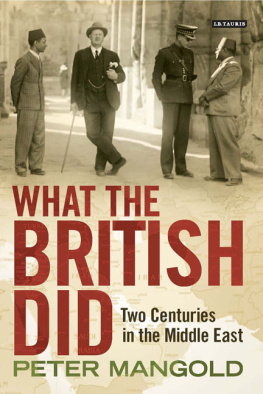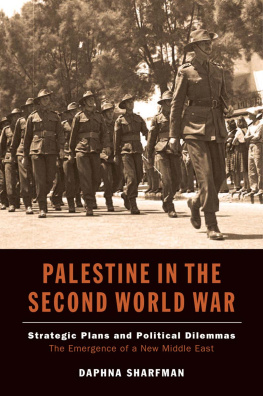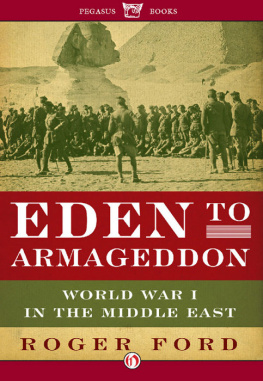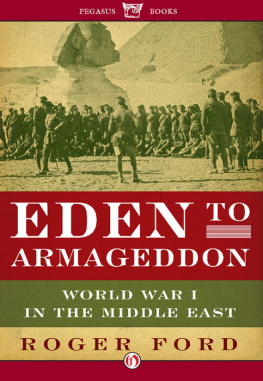Contents
Guide
Page List
THE FIRST WORLD WAR IN THE MIDDLE EAST
The First World War in the Middle East
KRISTIAN COATES ULRICHSEN
HURST & COMPANY, LONDON


First published in the United Kingdom in 2014 by
C. Hurst & Co. (Publishers) Ltd.,
41 Great Russell Street, London, WC1B 3PL
Kristian Coates Ulrichsen, 2014
All rights reserved.
Printed in the United Kingdom
Distributed in the United States, Canada and Latin America by
Oxford University Press, 198 Madison Avenue, New York, NY 10016,
United States of America.
The right of Kristian Coates Ulrichsen to be identified
as the author of this publication is asserted by him in accordance
with the Copyright, Designs and Patents Act, 1988.
A Cataloguing-in-Publication data record for this book is available from the British Library.
ISBN: 978-1-84904-274-1
www.hurstpublishers.com
This book is printed on paper from registered sustainable and managed sources.
No part of this publication may be reproduced, stored in a retrieval system or transmitted, in any form or by any means, electronic, mechanical, photocopying, recording or otherwise, without the prior permission of the publisher.
CONTENTS
This book could not have been written without the professional support, friendship and encouragement of Michael Dwyer and his colleagues at Hurst & Co. The value of a good publisher is inestimable and worthy of deep appreciation. A section of the research was presented at the annual meeting of the British Commission for Military History in Keble College, Oxford, in July 2012, and other parts drew upon the authors doctoral research at the University of Cambridge between 2002 and 2005. Academic colleagues at the London School of Economics and Chatham House provided further support and friendship, as did a small group of close friends who made the sometimes solitary task of writing a book a pleasurable experience. Finally, the book is dedicated to my parents and to my wife, in grateful recognition of their love and support.
|
|---|
Anzac | Australian and New Zealand Army Corps |
APOC | Anglo-Persian Oil Company |
CUL | Cambridge University Library |
CUP | Committee of Union and Progress |
EEF | Egyptian Expeditionary Force |
GHQ | General Headquarters |
HMS | His Majestys Ship |
IEF | Indian Expeditionary Force |
IOL | India Office Library |
IWM | Imperial War Museum |
LHCMA | Liddell Hart Centre for Military Archives |
MEF | Mesopotamian Expeditionary Force |
NAA | Northern Arab Army |
NILI | Netzakh Yisrael Lo Yishaker (The Eternity of Israel will not lie) |
OETA | Occupied Enemy Territory Administration |
RAF | Royal Air Force |
TNA | The National Archives |


A century on, the First World War continues to cast a long shadow across the Middle East. Two of the states that emerged from the legacy of the first large-scale, modern Western military intervention in the region lie in ruins. Iraq has been shattered by the baleful results of a renewed Western assault nine decades after a British commander assured Baghdadis that our armies do not come into your cities and lands as conquerors, but as liberators. Neighbouring Syria has been torn apart by civil strife as part of the post-2011 Arab uprisings that have shaken the post-colonial system of states and regimes to their core. Commentators and analysts alike have observed variously that the Arab Spring represents a second Arab Revolt or that it heralds the final unravelling of the SykesPicot legacy. In each case, the terminology hearkens back to developments during the First World War as it was this conflict, more than anything else, that determined the nature of the state-system which later emerged. Other, more recent, forces such as Arab nationalism, political Islam, revolutions, terrorism, civil wars and, not least, decades of superpower rivalry and ArabIsraeli conflict have all transformed the region and its place in international politics. Nevertheless, the legacy of developments and decisions taken during and after the First World War remains a source of bitterness, contestation and conflicting interpretation to this day. This reflects the fact that the war years represented a transition of the region from a crucible of competing empires to the emergence of the modern state-system with all that implied for the realisation and crushing of national aspiration, the recasting of loyalties and the birth of grievances that have come to occupy totemic positions in regional narratives.
This book explores the multiple conflicts that took place between August 1914 and November 1918 in the Middle East and North Africa. It examines the fighting that took place between the Russians and the Ottomans in the Caucasus, the forces of the British Empire and France and the Ottomans at Gallipoli, and British and Indian troops and the Ottomans in Palestine and Mesopotamia, as well as smaller outbreaks of fighting elsewhere in North Africa. Some of the battles have become immortalised in historical and national memories. Gallipoli is the most notable example and its centenary will be widely commemorated in Turkey, Australia and New Zealand in 2015. Other battles have mostly been forgotten, despite the terrible toll they exacted on participants and bystanders alike. A prominent example is the Battle of Sarikamis in December 1914, in which nearly one in two Russian and Ottoman combatants perished as tens of thousands froze to death in winter snowstorms at an altitude of nearly 2,000 metres above sea level.
Caught within the crosshairs of four empires vying for different aspects of regional supremacy, the Middle Eastern theatres of war were characterised by vicious fighting in treacherous conditions along extended and vulnerable lines of communication. In addition, the heavy logistical demands of sustaining an industrialised conflict in the largely pre-industrial terrain of the Middle East made enormous demands on host societies and local communities. The voracious demands for food and fodder, animal-and manpower necessary to supply and transport the vast imperial armies had a devastating impact on non-combatants already living close to or under the margins of subsistence. Greater still was the hardship caused by forced displacements and the economic dislocation resulting from the carving out of competing and hostile spheres of influence and control. Worst of all was the Armenian genocide of 1915, in which up to a million Armenians were slaughtered in an orgy of mass killings and death marches that continue to resonate to this day.












